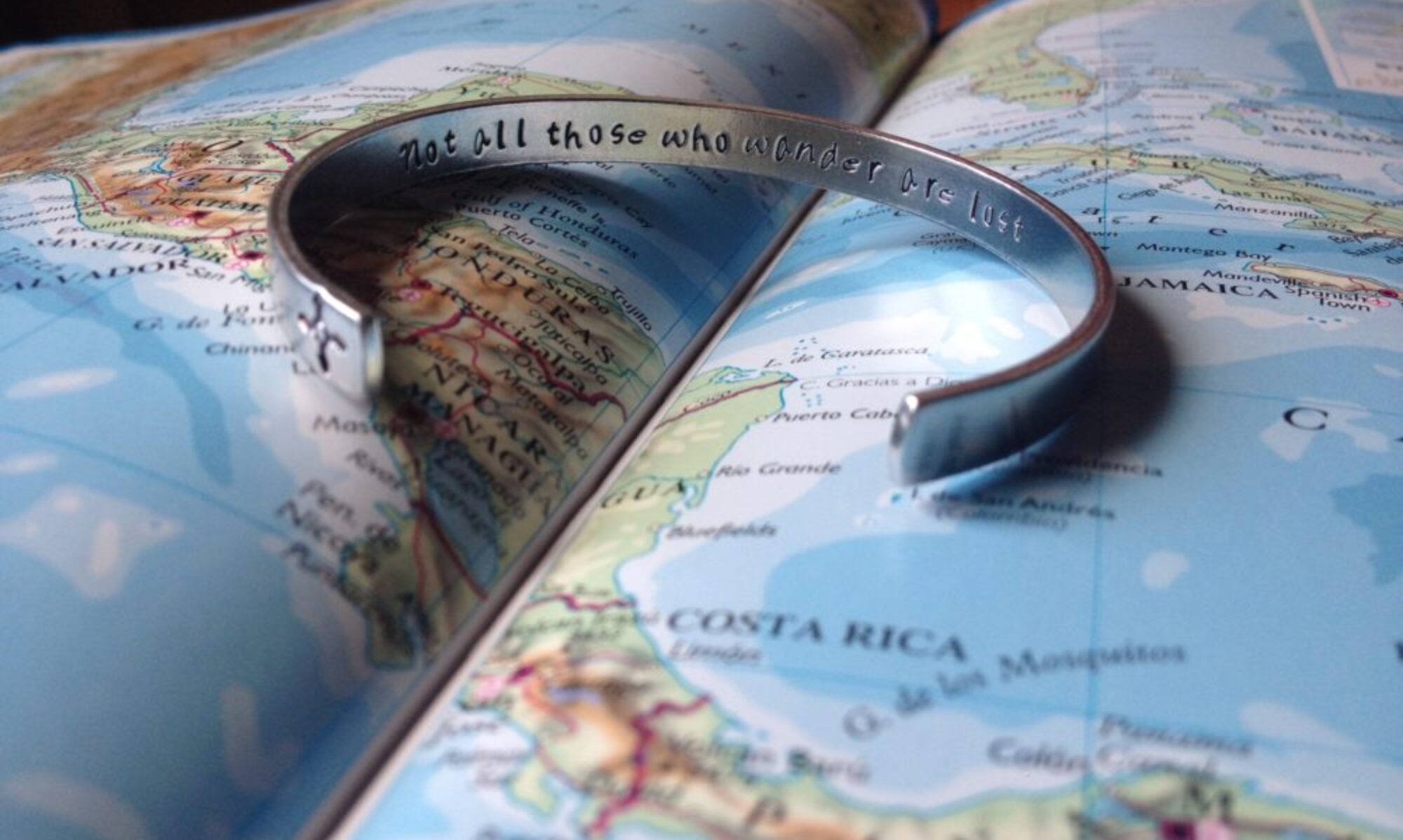They say when its time, you just know.
The last time I took a trip with my parents was when I was 14 and had a rather amusing fashion sense.
This year, being the 30thwedding anniversary of the two most wonderful people on the planet – I decided that it was time.
After months of deliberations and intensive sessions of poring over the hundred open tabs in my browser window – in combination with the Eid holidays being pushed a couple of days in front – the much anticipated Europe and UK trip was set in motion.
Starting from Muscat, we were flying into Munich – and then quickly crossing the borders to go to Austria. For Indian citizens, its best to get a Schengen visa done from the Embassy of the country in which they will spending the most time in, or the first point of entry. In Muscat, the German Embassy (located in Hamriya) has the speediest processing (three working days – I was very impressed!), but your documents have to be perfect. In the peak tourism season, appointments are booked ahead by months – so make sure you prepare with at least a month in advance in this period.
Getting back to the journey, we took the Oman Air flight directly from Muscat to the Franz Josef Strauss International Airport or Flughafen München in German. You will do good to remember a few German words while travelling through this part of the world – Flughafen, meaning airport, is one of them. Others I will mention as and when we come across them.
We had to take a train from the airport directly to the Munich HBF or München Hauptbahnhof – the latter of the words stands for central station. So it goes like ‘Bahn’ is Rail, ‘Bahnhof’ is Rail Station and ‘Hauptbahnhof’ is the main rail terminal. All this gyaan comes from my one year of German at the Max Mueller Bhavan in Pune. You’re welcome.
Taking the underground Deutsche Bahn (DB) train connection from the airport to the Munich HBF, we underwent a laborious luggage haul (there are no escalators or elevators) to reach our platform to wait for the train that would take us to Salzburg. Most of the German and Austrian rail network is operated by the crimson branded ÖBB (Österreichische Bundesbahnen) – and it would do you good to remember the name because they are bloody well the best trains I have seen. Yet. The carriages have special baggage holding sections and large overhead spaces where you can stow your belongings and then not worry about them because you have the Austrian countryside unfurling in front of you.
 |
| Wilkommen! |
From the moment the train moves from the platform, all you can see from the large windows is an expanse of green, bordered by the Alps – which almost never leave you. Pulling into the Salzburg HBF around two hours later, I was already feeling like this would be like a place I had never been to before. The green was disturbed only by little villages made of wooden or bricked cottages and cabins with the signature roofs and of course the many lakes and all kinds of cattle. Classic storybook European countryside.
 |
| Salzburg HBF |
We got into a cab for a quick five minute drive to the cozy
Hotel Mozart – a family run establishment which has almost no negative comments on TripAdvisor. I could sense why, from the moment we stepped out of the taxi. Not only would Bruno – the reception in-charge at the time, not allow us to pick up the luggage
(because we’re ladies and oh so dainty!), he provided us with a detailed map marking out attractions and his recommendations for places to dine. We had booked the
‘Eagle’s Nest and Sound of Music Tour’for the next day from Expedia – and he even volunteered to call the tour company and confirm our attendance and arrange a hotel pickup! There could have been no better start to the trip.
 |
| Hotel Mozart! |
After a quick refresh break, we stepped out, followed Bruno’s map towards old Salzburg and found ourselves stepping on roads made of stone into narrow passageways lined with cafes, patisseries and souvenir shops. The first time I had heard of Salzburg was from Baba, and in the obvious context – Mozart. This was the little salt-mining town in which the genius was born and lived for a good bit of his life. For those not interested in classical music, there’s lots more for them as well. The Von Trapp familylegacy was also based in this town – immortalised by Richard Rodgers and Oscar Hammerstein’s award-winning ‘The Sound of Music’.
 |
| The heart of old town |
 |
| Fountains spring up in the middle of the road. No big deal. |
 |
| The Markartsteg ie bridge leading to the market |
 |
| The fortress of Salzburg |
The first thing you will notice in the city are the graceful domes and spires, the formidable cliff-top fortress which was built to protect the royalty in times of war and the mountains beyond. Since most of the next day would be covered because of our expedition, the objective was to cover the important things to see in old town. We walked to Mozart’s birth house (Mozarts Geburtshaus) and then onward to the house he had lived in – the Mozart Wohnhaus which are both museums which hold important parts of his life and work that time has not been able to wipe out. To be able to see a lock of his hair, to the violin that he played from behind a glass pane is no less thrill. From when I was very young, I have heard my father talk about this man and his music. I’ve grown up listening to concertos, sonatas and operas just like the television or radio would blare in any other household – so you can imagine that my father was as entranced as he could get. It has been a lifelong dream for him, and it felt great to be able to come with him and at least metaphorically walk the same roads as so many legends of the period. So yes, long story short, any place associated with Mozart – we visited. The best part being that we did not need any public transport to get around the city – almost everything we wanted to see was within walking distance, hence very convenient!
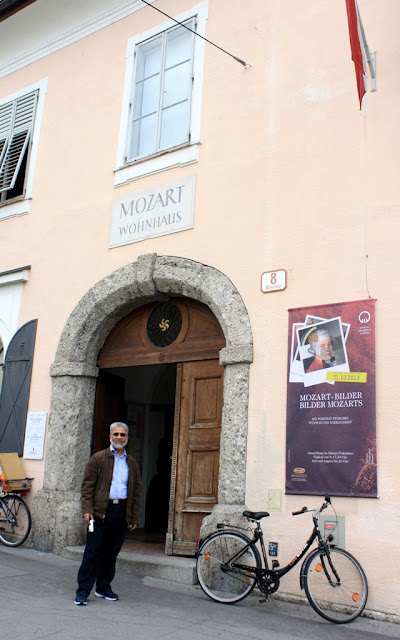 |
| Starting out at the Wohnhaus. Easier to get to – through Mirabellgarten. |
 |
| The birth house. |
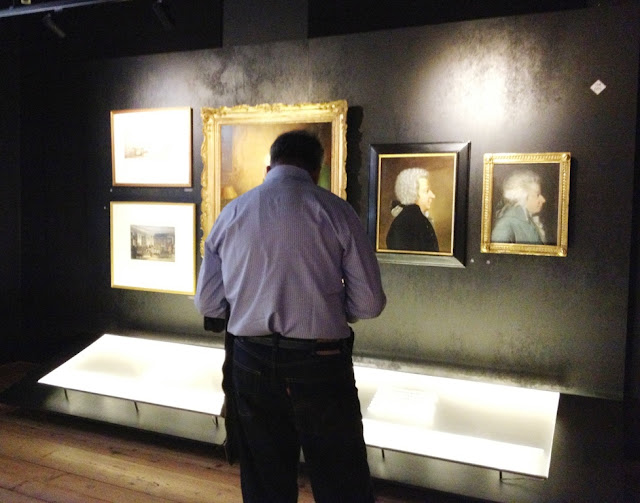 |
| Mozart, through the ages. |
 |
| Apparently, this is the portrait that looks closest to his real person. |
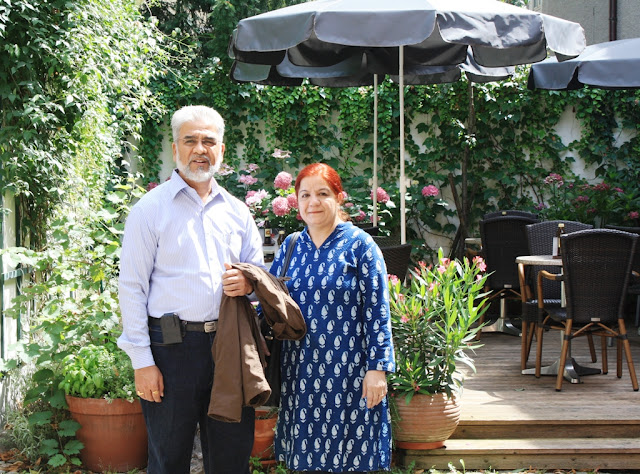 |
| In the sunny courtyard. |
As stomachs began to rumble, and the unnatural high temperatures drained a bit of the tourist energy in us and we settled on lunch at the K+K Restaurants, near the Mozartplatz for some yum ravioli and duck dish and the so very famous Apple strudel
(Apfelstrudel), a traditional Austrian pastry jacket with delicious apple filling. We later ambled around the Marketplatz, saw the stunning Salzburger Dom
(It is a cathedral – got absolutely to do with a burger :P) and retired to the hotel for a bit as the sky had begun to darken, promising rain.
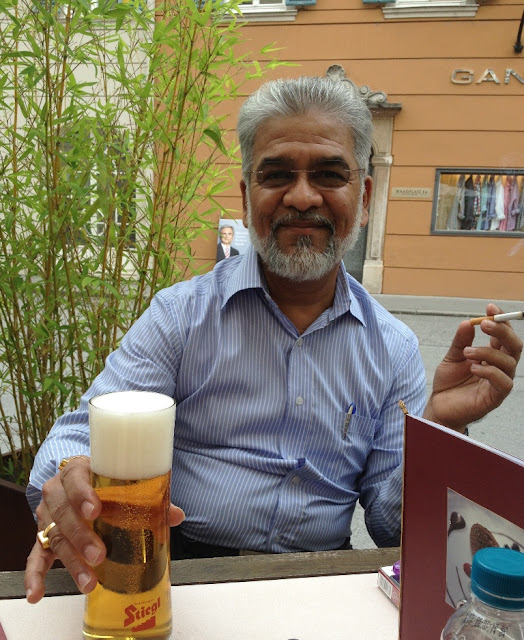 |
| Baba and Stiegl |
 |
| Lunch! |
 |
| Apfelstrudel. Yum! |
 |
| Ledge 🙂 |
 |
| Mozartplatz. |
As Ma and Baba caught up a bit on sleep, I couldn’t stay put with the thunder and lightning, and sat myself on the extra wide window pane (a characteristic feature in the architecture of the buildings in this country) and wrote my journal listening to the rains lashing down and clouds descend and circle around the tip of the mountain.
 |
| Droplets… |
At 8 pm, when the Sun only started to set and the rains stopped, we walked to the nearby Mirabellgarten (The gardens in which Maria and the children sing ‘Do-Re-Mi’), the ornate gardens adjoining the Mirabell Palace which belonged to the Austrian-Hungarian Archbishops and has formed one of the most popular tourist destinations in the city. As it got dark, we heard music from the centre of the park and walked towards it to find a small wind-instrument orchestra performing – I guess you can only find such things in a city so drunk on music. After a quick dinner we spent time sitting by the rushing Salzach River that runs through the city, watching the street lights dancing on the flowing water. There was a slight chill in the air and I could spend hours watching people leisurely cycle by, while a man played the piano accordion on the bridge.
 |
| They played traditional Austrian melodies and the audience sang along.. |
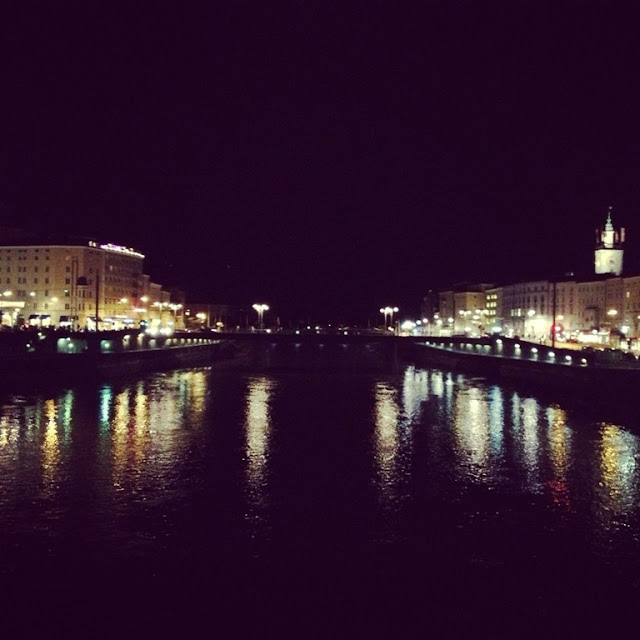 |
| The Salzach |
 |
| Where else can you find bread baked as violins |
The next day we were up and ready in time for our pick up by Grayline Tours for the Eagle’s Nest and Sound of Music tour.
When in Salzburg, I would recommend these two excursions as a must-do. Well, they are definitely touristy but they show you a part of the country that you most probably wouldn’t be able to see otherwise – not to forget, with an excellent guide.
About the destinations – The Eagle’s Nest or Kehlsteinhaus is a chalet-style structure erected on a sub peak called Kehlstein and at 6,017 feet was intended to be a 50th birthday present for Adolf Hitler to serve as a retreat, and a place for him to entertain visiting dignitaries. Following an hour’s drive from Salzburg, we cross into Germany and take a bus to the lavish structure which was completed in 1938, walk through a bone-chilling corridor and board the original brass elevator to enter the building. It is amazing to experience the history that accompanies the place, see the marble fireplace that Mussolini has presented Hitler with and step into Eva Braun’s room which is made completely of chestnut wood. Not to forget the little hike up a mountain path from where you can see the aptly named Eagle’s Nest with the breathtaking panorama of the Bavarian Alps as a background. You have to stop for a breath and to admire the vista.
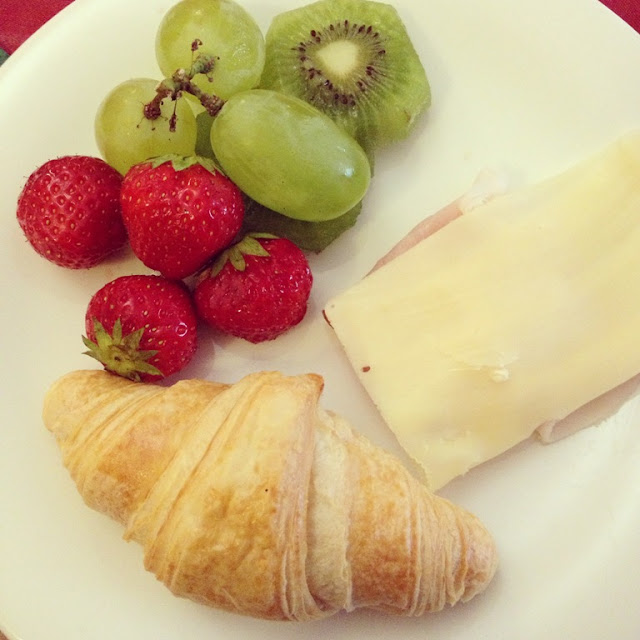 |
| Breakfast! |
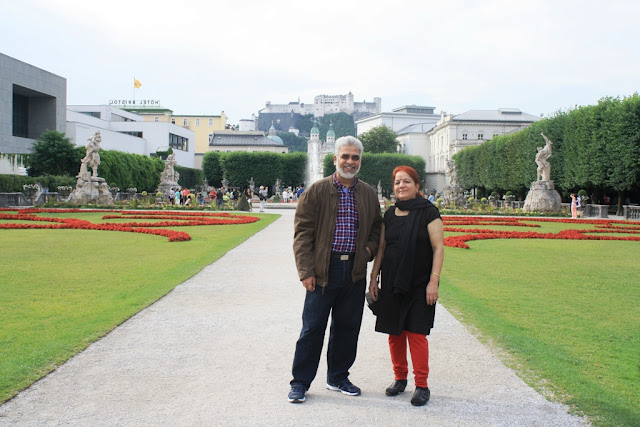 |
| Mirabellgarten.. |
 |
| Lavender love |
 |
| I could sit here all day! |
 |
| Impressed? |
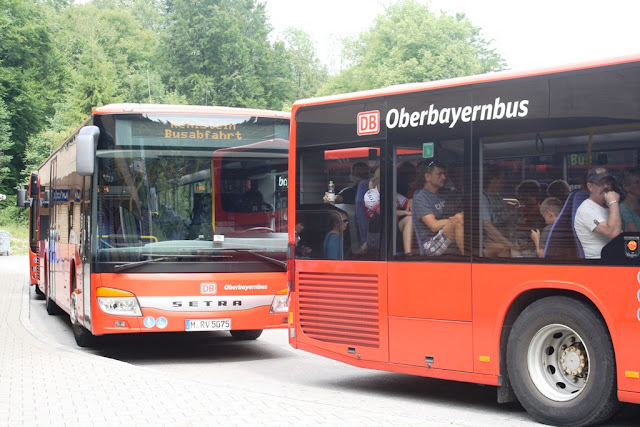 |
| Taking the bus up to the Kehlsteinhaus |
 |
| Aushtria – as they say it. |
 |
| The original entrance to the Eagle’s Nest still stands |
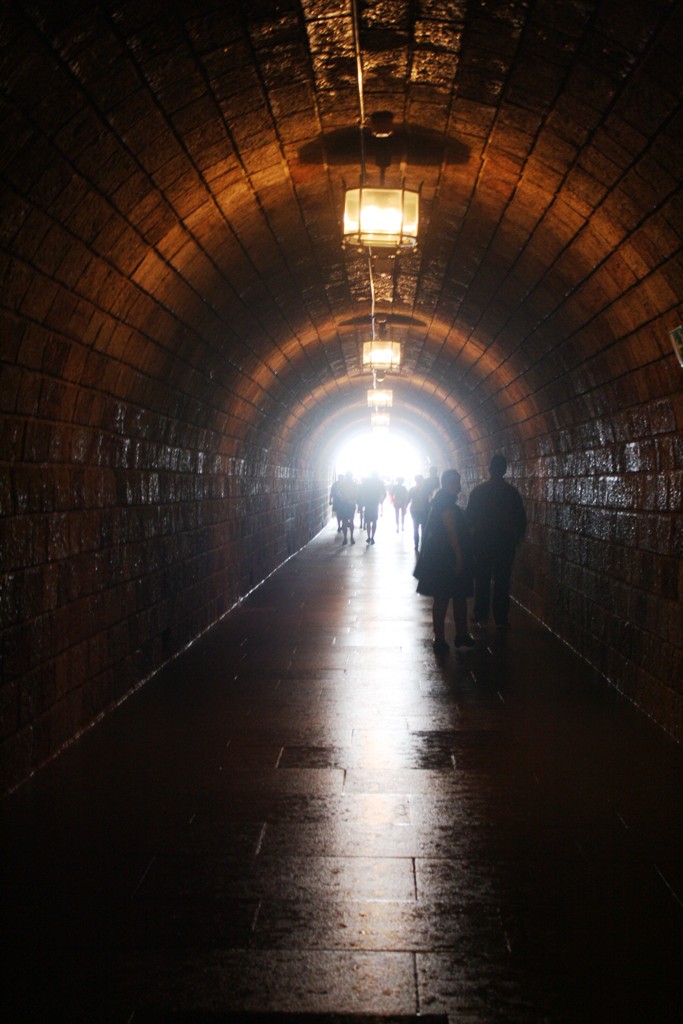 |
| The freezing stone corridor |
 |
| What used to be the greeting hall, now converted into a restaurant |
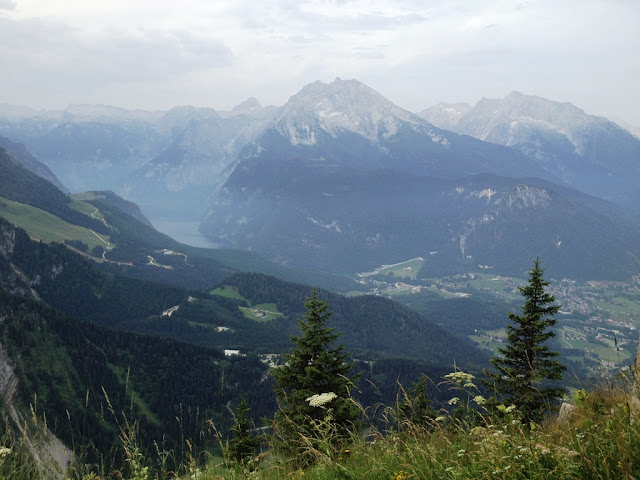 |
| Stop. Breathe. Repeat. |
 |
| The house from the top |
 |
| Enjoying the views as the air cleared |
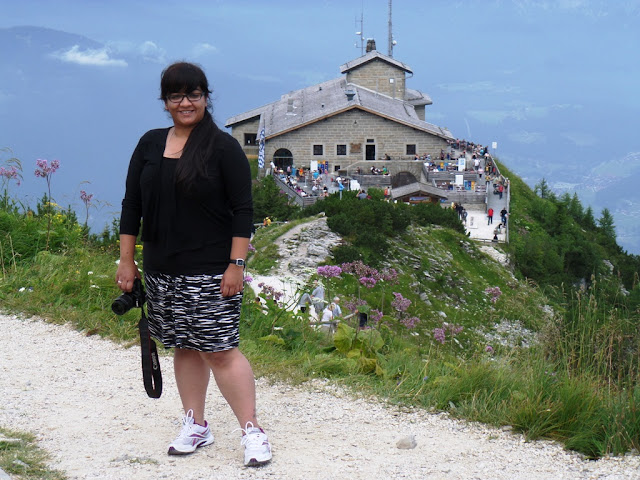 |
| Once the panting had stopped! |
After a couple of hours at the house, we head back to Salzburg town to grab lunch quickly and get started with the Sound of Music tour, with our Spanish guide Antonio who speaks German
(Yes, I know) – and sings along with all the songs that played in the bus. We visited the houses where the movies were shot – Schloss Leopoldskron and the pavilion at the Hellbrunn Palace of course where the gazebo sits
(Remember “I am 16, goingon 17”?) and stopped by a number of lakes
(Fuschl & Wolfgang) and little towns on the way. We were surprised to know that hardly anything was filmed in Austria, except the exteriors of the Captain’s house, the hills at the beginning of the movie and the chapel at Mondsee where the couple marry. Regardless, the film has been etched in our hearts and visiting Salzburg seemed to brought all the memories to life – especially in a bus full of adults singing
“Raindrops on roses and whiskers on kittens”
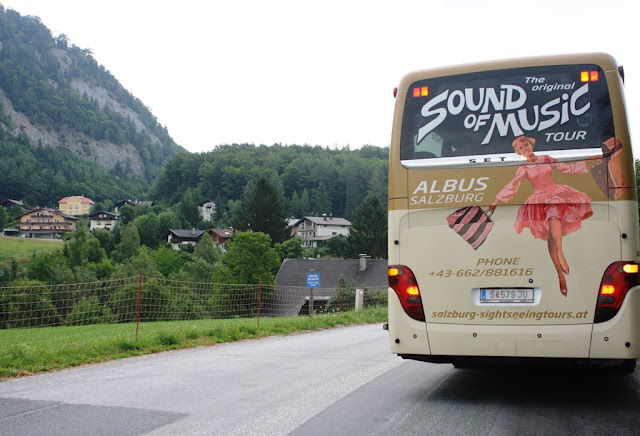 |
| The bus! |
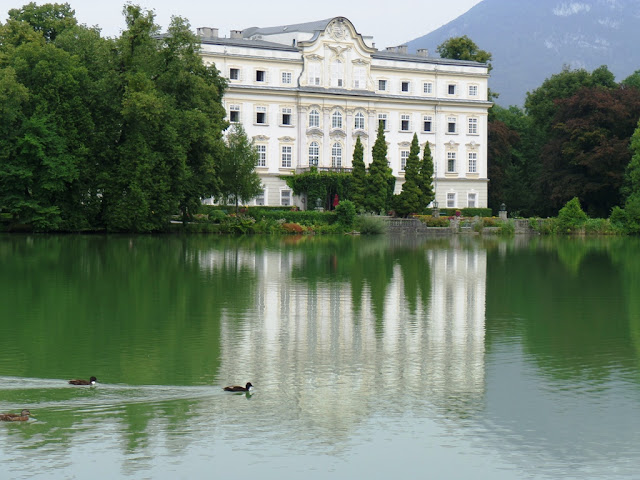 |
| Where the children fall into the lake! |
 |
| Can picture Rolf and Liesel do the dance! |
 |
| Lake Fuschl. |
 |
| Mondsee Church |
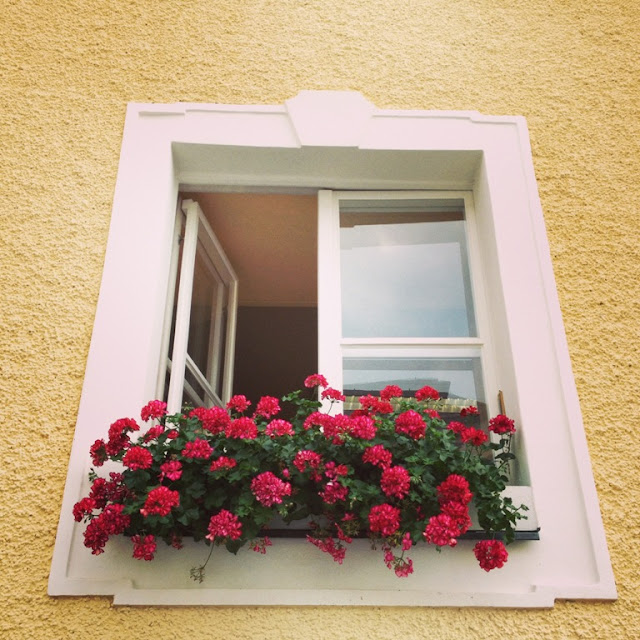 |
| Could not help falling in love with these windows |
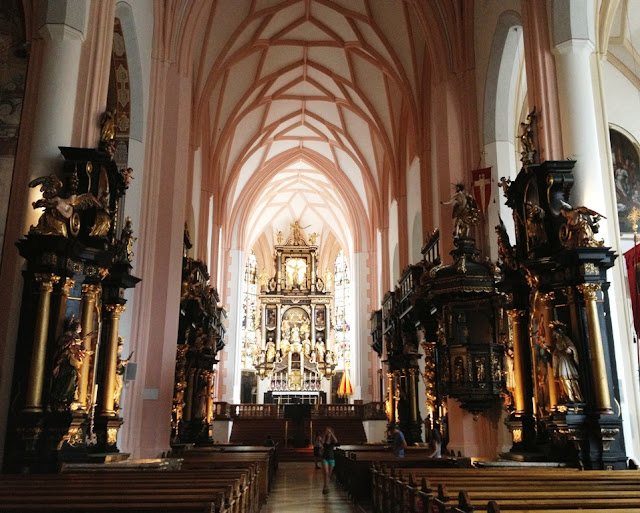 |
| Rose tinted interiors of the church |
After dinner at Pasta + Vino and a quick walk around the Salzach, we retired for the night – all packed and ready to say goodbye to the city of the Salt Fortress.
We took an OBB Rail Jet train to Vienna and when I realised that there was free WiFi, I actually groaned that the journey was for just over two hours.
 |
| Happy parents on the Rail Jet. |
Wein, as it is known in German is one of the most prominent cultural capitals in all of Europe. I quote Lonely Planet when they say, “We often see Vienna in terms of its grand past: angelic choirboys, monumental palaces, horse-drawn carriages and flamboyance. The tones of Mozart, Beethoven and Brahms and the filigree paintings or sketches of Klimt, Schiele and Kokoschka. But this is to ignore its dynamic present.”
There isn’t enough one can say to describe this city – and I have felt the spirit having walked the streets, sat at the roadside cafes and spoken in broken Arabic to a Turkish falafel man whose German accent masks the Arab one.
Music brought us here. And history. And of course Mozart once more, because he spent a large number of years in the city spinning magic and pleasing the aristocracy. He is even buried here at the Saint Marx Cemetery. That is the first place we went to once we reached
DerWilhelmshof, our hotel – using the faultless Viennese underground public transportation. A special note for the U-Bahn
(the Vienna underground) and the entire system that makes travelling so much easier for tourists – a single purchase 24/48 hour ticket enables you to travel by metro, bus or tram which covers the expanse of the city. I’ve hardly seen a better organised transport mechanism!
Moving forward, we visited Mozart’s burial site (U3 to Simmering and the Tram #71 to Sankt Marx and a short walk) and the Central Cemetery (U3 to Simmering and the Tram #71 to Gate/Tor 2 of the Zentralfriedhof) where Beethoven, Brahms, Schubert and Strauss are buried – amongst 330,000 others. I’m guessing not too many people like seeing crypts while on vacation, but to me it would be a huge loss if we went that far and didn’t take a moment to kneel in front of the bones of these people who redefined western classical, as we know it. As sunset was approaching, we zipped across the city on a tram and the U-Bahn to the Donauinsel a narrow island on the river Danube, watching kids roller skate and the Sun go down as the lights began to turn at Vienna’s own little Copacabana – the Copa Cagrana. The part I liked best about the Donauinsel was the fact that the moment you exited the train, you could feel the cool breeze from the river and there were niches made as a part of the bank design as if they wanted people to be comfortable and enjoy the sunset. I was only in Vienna for two days, but if I lived there – this would be my most favourite place.
 |
| The mirage that was the St. Marx Cemetery. |
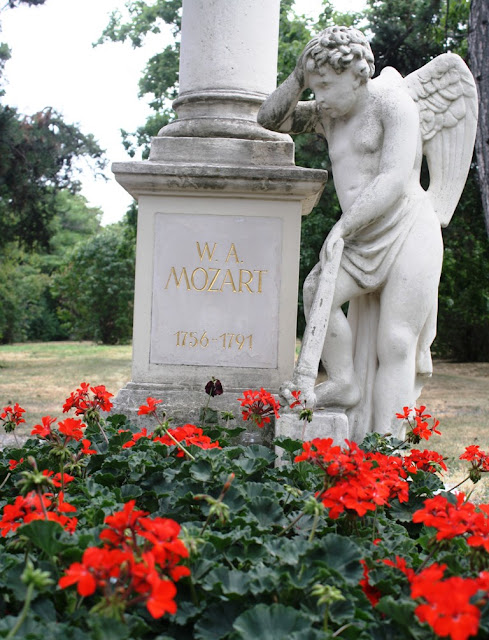 |
| Even the angels despair |
 |
| The Central Cemetery |
 |
| Ludwig Van Beethoven rests here. |
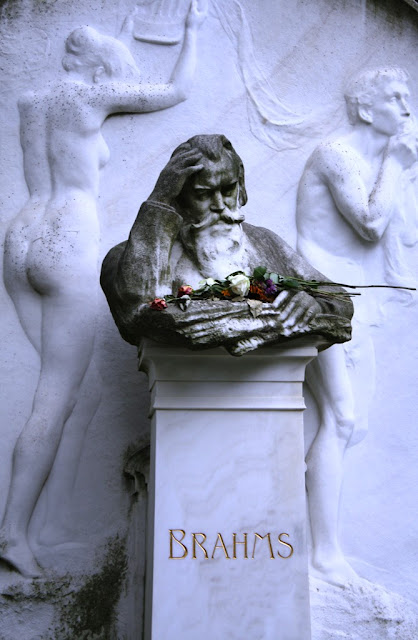 |
| Old man Brahms. |
 |
| A tribute to Mozart |
 |
| Blue Danube, a shade of sepia |
Dark clouds gathered while we were on our way back to the hotel and by some sort of incidental planning, it began to pour as soon as we got into our rooms. I plugged in Billy Joel singing ‘Vienna’ and prepped up the bath water for a soak while Baba watched random German television and Ma made chicken Maggi on our portable tea maker!
The next day we visited the fascinating Schönbrunn Palace – a former imperial 1,441-room summer residence of imperial Austria and one of the most significant cultural sites in the country. There can just not be enough said about the lavishness of the palace – almost in comparison to the one at Versailles. I learned that the Austrian people are deeply involved in the life of the then Emperor Franz Josef I and especially his wife Empress Elisabeth (fondly known as Sisi). This baroque complex contains an enchanting park and maze, the Palm House, a Gloriette and also a zoo. We took what is called an ‘Imperial Tour’ that walks us through over 30 rooms with an audio guide and gaped open-mouthed at the contents of the extravagant household.
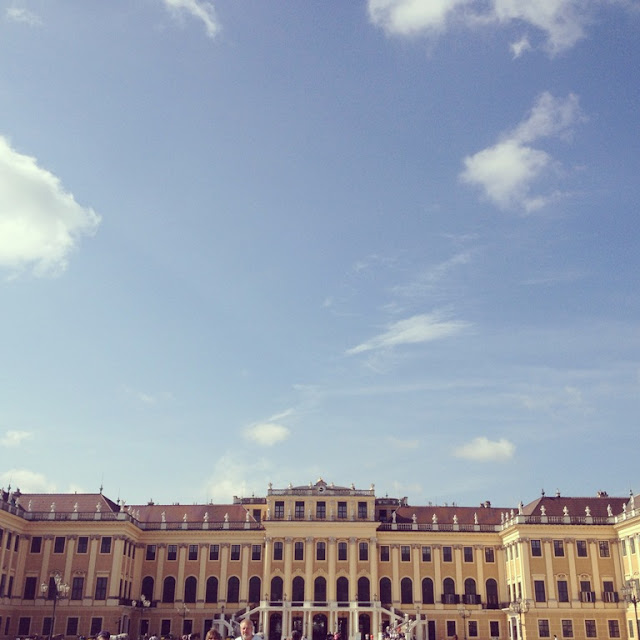 |
|
Schloss Schönbrunn
|
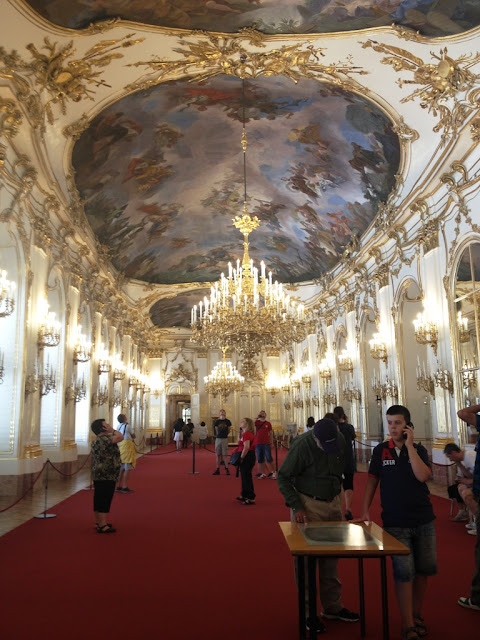 |
| Interiors :O |
 |
| Posers! |
 |
| The Neptune Fountain |
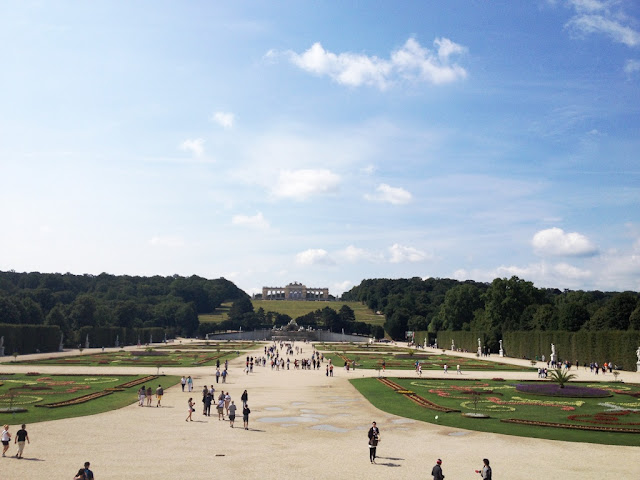 |
| The expanse and the Gloriette in the distance |
 |
| The garden labyrinth begins |
Wrenching ourselves away from the beautifully manicured gardens, we took the metro to central Vienna. Getting off at Stephansplatz, as we climbed the stairs up to the exit, the towering St. Stephen’s Cathedral or Stephansdom rose in front of us. So massive and beautiful was the structure, that no matter what I did, I wasn’t able to get a satisfactory picture of it. Yet another thing about Europe was the stunning architecture that its monuments, cathedrals and even normal homes have – baroque or not – I’m glad that they are in the right hands to preserve.
If you take the road right behind the cathedral, you will reach Mozarthaus – one of the places where Mozart lived while in Vienna, as usual – beautifully preserved and turned into a museum. Hopping on and off the U Bahn, we visited the imperial palace of Hofburg, the Maria-Theresia Platz, Volksgarten and number of Viennese landmarks. At Karlsplatz, after grabbing a burger each for lunch, we scrambled on to our hotels to get a bit of rest – we had an interesting evening planned ahead.
 |
| St. Stephens Cathedral |
 |
| Stone paved |
 |
| At the Mozarthaus. |
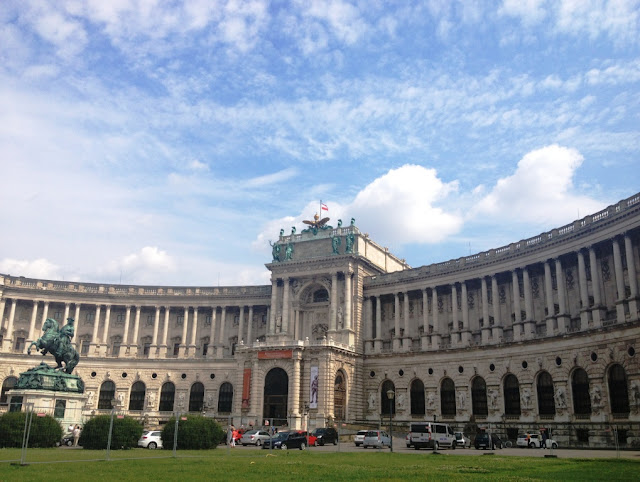 |
| The imperial Hofburg |
 |
| Tired feet! |
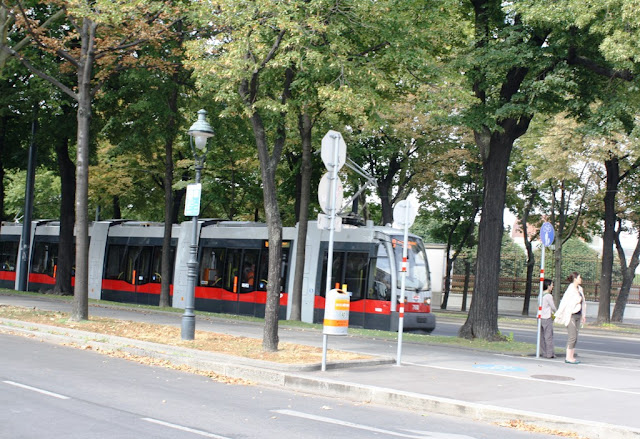 |
| Tram in Wien |
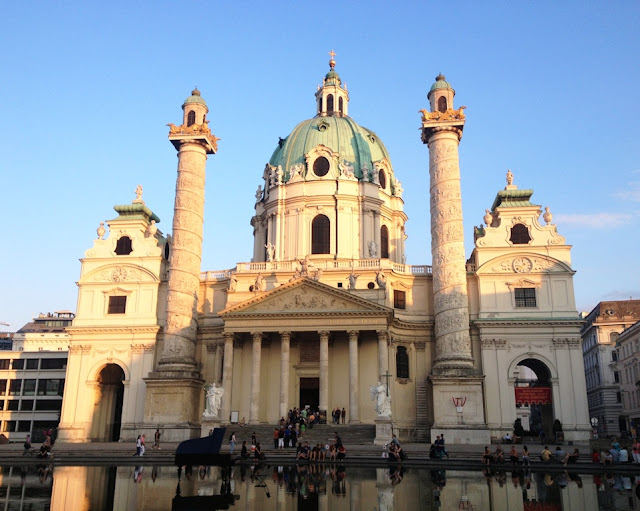 |
| A piano in the middle of a pool. One of Vienna’s music halls. |
It would seem incomplete to come to Vienna and not listen to some classical music – so I had booked us tickets for the Vienna Mozart Orchestra’s performance in period costumes at the Musikverein – one of Vienna’s prominent concert halls. After getting off at Karlsplatz and a little stumbling around to find it, we entered a reception hall that was packed to the brim with people aka tourists. Among the madness, I managed to exchange our online vouchers for tickets and proceeded to the hall. The first recital was conducted here in 1872 and true to that, once you enter, you are transported back to the same era. The acoustics were fantastic and the soprano just won the audience over. They played Mozart classics – the Eine Kliene, pieces from Don Giovanni and the Marriage of Figaro. The show concluded with a resounding and continuous applause that just went on and on until the artistes left the stage.
 |
| Gold, gold everywhere. |
 |
| The Staatsoper! |
At about half past ten, and we remembered that we hadn’t had dinner. So NYC style, we found ourselves a Turkish Kebab joint (these are very popular in Vienna) in front of the majestic State Opera House and got ourselves a couple of doner kebabs, schnitzels, and more junk takeaways! Trip back to the hotel and got packing again!
The next day we took a pre-booked CAT (City Airport Train) from Landstrasse and were transported directly to the Vienna International Airport, to take our British Airways flight to London and start with the organised tour. But since we’re already in Austria, I thought it would be a good idea to include Tirol, the beautiful town of Innsbruck into this post.
We travelled to Innsbruck on the way back from Switzerland, having spent the morning in the delightful little principality of Liechtenstein. The destination is Wattens to visit the home of Swarovski Crystal World. We spent some time with the green giant of Kristallwelten and ambled into the many rooms of the museum that have been created entirely out of crystals. I was honestly not blown away until we reached the store at the end of the museum and then of course, our pockets were considerably lighter afterwards.
 |
| Inspiration. In crystals. |
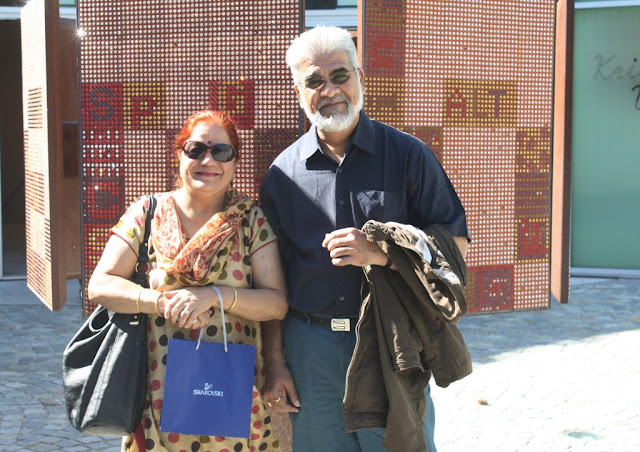 |
| Poor Baba. |
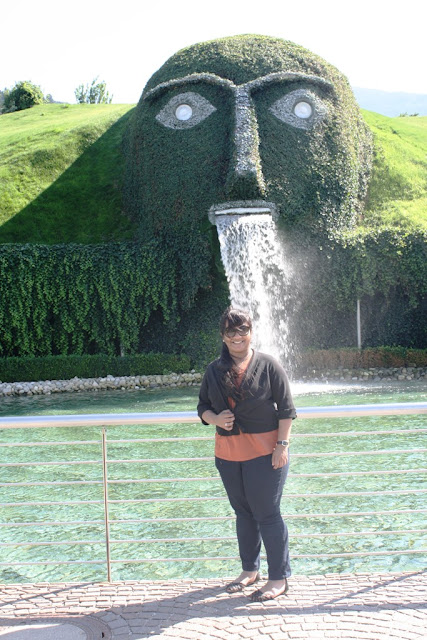 |
| The giant and me! |
 |
| One of the many crystals that caught my eye |
 |
| Snowy Alps behind us. |
After a city tour of Innsbruck we were dropped off at a square that used to be the main street of old town Innsbruck, the Herzog-Friedrichstrasse. Right in front of us was the Goldenes Dachl or Golden Roof – a three story balcony capped with 3,657 gold plated tiles on a porch built for Maximillian I. It is said that it was on this balcony that the Emperor sat to observe the beauty of the Alps and the buzz of the town below. It is a symbol of Innsbruck and a shining one at that – but we were soon distracted by the beauty of the entire square. The Best Western Hotel Goldener Adler Innsbruck was a major attraction with a marble plaque outside mentioning the names of the rich and famous who had stayed there – counting names like Albert Camus, Heinrich Heine, Nicolo Paganini, Jean Paul Sartre and most recently the crown prince of Brunei!
We walked past the many bakeries and came to a bridge beneath which the river ‘Inn’ flows – giving the city its name. With the warm sun, a gentle breeze and someone playing the pan flute in the distance, there was probably a moment when I realised that Austria would be my most favourite place – even without having seen everything.
 |
| The Goldenes Dachl |
 |
| River Inn |
 |
| Warm and sunny Innsbruck! |
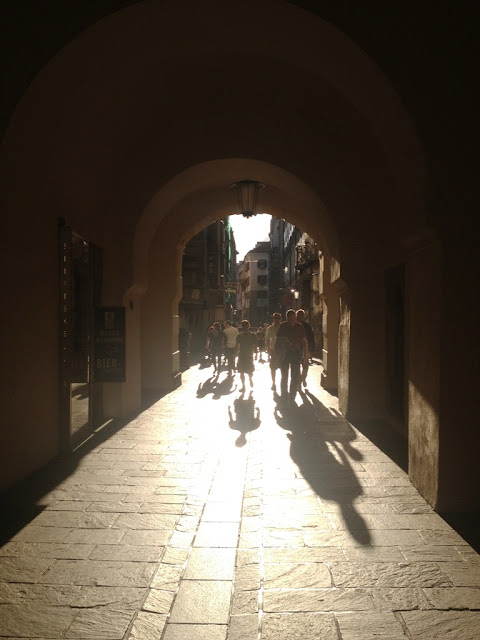 |
| Love! |
The evening marked our last night in Austria and what fun it was going to be. We went to a Tyrolean Folklore Show by the Family Gundolf who are immensely talented. Not only do they speak any language we can think of – Taiwanese, Hindi or even Arabic, they yodel like a dream, make music from cow bells and a saw, and do the traditional Austrian dance like ace – looking at which made my calves hurt! Here is a bit of bloody awesome all the way from Austria for your ears only!
 |
| Accordion and harp. Magic music. |
So that was Austria, officially known as the Republic Österreich. My clear favourite, if we don’t count Switzerland. Although we explored the cities on foot, and in detail – I’m thinking of going back one winter where the Alps are covered in a sheet of white, and the whole landscape is transformed. Till that time, as the Austrians say – Auf Wiedersehen.

